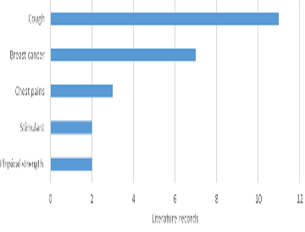Abstract
Maerua pseudopetalosa (Gilg & Gilg-Ben.) DeWolf is a perennial herb or subshrub collected from the wild as a food plant or traditional medicine. Maerua pseudopetalosa occurs naturally from Senegal, east to Eritrea and Ethiopia, through South Sudan, Sudan, East Africa, south to the Democratic Republic of Congo (DRC). This study is aimed at evaluating the chemical properties, biological activities and ethnomedicinal uses of M. pseudopetalosa. Results of the current study are based on data derived from several online databases such as Scopus, Google Scholar, PubMed and Science Direct, and pre-electronic sources such as scientific publications, books, dissertations, book chapters and journal articles. This study revealed that the fruit, leaf and root infusion and/or decoction of M. pseudopetalosa are mainly used as a stimulant and to restore physical strength and vitality, and traditional medicine for chest pains, breast cancer and cough. Phytochemical compounds identified from aerial parts, fruits, roots, seeds and tubers of M. pseudopetalosa include quaternary ammonium compounds, alkaloids, amino acids, betaines, cardiac glycosides, fatty acids, essential oils, flavonoids, phenolics, sterols and tannins. Preliminary ethnopharmacological research revealed that aerial parts, roots and tubers of M. pseudopetalosa have antibacterial, antifungal, antihyperglycemic, antioxidant, α-glucosidase inhibitory, pancreatic lipase inhibitory and cytotoxicity activities. Maerua pseudopetalosa should be subjected to detailed phytochemical, pharmacological and toxicological evaluations aimed at correlating its medicinal uses with its phytochemistry and pharmacological properties.
Full text article
Authors

This work is licensed under a Creative Commons Attribution-NonCommercial-NoDerivatives 4.0 International License.

